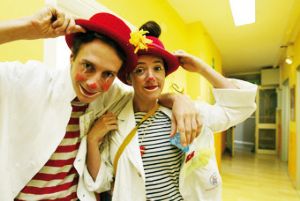When one thinks of Italy, beautiful artwork, historic buildings and, of
course, fashion come to mind. The House of Gucci, one of the most renowned and
successful Italian brands, celebrates its 90th anniversary this year with the
opening of a museum in the heart of Florence’s Piazza della Signoria. Inside
this permanent exhibit, visitors can take a walking tour of Gucci’s history,
beginning with the company’s first leather suitcases and culminating with the
glamourous evening gowns worn by Hollywood’s most famous. There is even a 1979
Cadillac Seville, complete with Gucci’s GG logo on the rims, canvas top and
interior.
The unassuming exterior of the Gucci Museum, housed in the Palazzo della
Mercanzia, belies the historical significance of the building. One small plaque
on the outside wall alerts passersby to the existence of the museum. Built in
1337, the building is a fitting choice: in the Middle Ages, the palazzo housed
an office dedicated to the protection of local guilds, among them Florentine
cloth importers, wool manufacturers and silk weavers. The coats of arms of these guilds hang in the museum’s
café on the ground floor, already a regular haunt for the city’s chic and
fashionable.
The location of the Gucci Museum makes sense for another reason: Guccio
Gucci, who founded the company in 1921, was a native Florentine (see TF 104).
The first Gucci store opened its doors in Florence, selling classic leather
luggage pieces inspired by the rich, elegant patrons of the Savoy Hotel in
London. The exhibition thus begins with Gucci’s travel items, with suitcases, hatboxes,
duffels and trunks representing the firm’s nine decades. The timelessness of
the brand is obvious: with just slight changes, the luggage from the 1950s is
comparable to that of the 1980s. The green-red-green webbing so typical of
Gucci’s designs, is often repeated.
The Palazzo della Mercanzia retains its original façade, but inside the
museum’s décor is contemporary and minimalist. This combination of new and old
is inherently Gucci, whose philosophy is ‘forever now.’ According to its
website, Gucci ‘celebrates the creativity of the past as inspiration for the
future.’ The simple white walls and black floors don’t distract visitors from
the vibrant collections.
The collection is arranged thematically. The basement houses the Gucci
archive, a vast array of ready-to-wear clothing, accessories, photographs and a
very big ‘Caddy’ dressed in the GG logo. The ground floor includes the café
(which offers free Internet access), a gift shop, a bookshop and the travel
collection. The first floor holds displays of evening wear, handbags, precious
jewelry and flora, as well as contemporary art. The second floor showcases pieces from the
‘logomania,’ lifestyle and sport sections.
The metal-fringed evening bags, crystal-studded clutches, gold brooches
and silver make-up cases on the first floor show Gucci’s ability to cross the
practical with the luxurious. The two contemporary art spaces on the second
floor show video artwork from American video artist Bill Viola (see TF 124) and
clips of such influential films as Fellini’s La Dolce Vita. Since 2006, Gucci has partnered with the Film
Foundation to restore one classic film per year, and a video loop shows clips
from each film that Gucci has thus far helped restore.
The display of handbags attests to the remarkable variety of materials
that Gucci has used over the years, from suede to satin, ostrich to pony.
During World War II, a shortage of available materials forced the company to
experiment. Some of those experiments resulted in important trends: bamboo-handled
bags introduced in the 1940s later became favorites of fashion idol Jacqueline
Kennedy Onassis and screen star Sofia Loren. A video loop in the handbag room
shows how artisans used fire to soften the bamboo and bend it into the handle
shape.
The display that inspires most visitors to linger is the one featuring
Gucci evening wear. The exhibit features five dresses made for actresses to
wear at the Cannes Film Festival and the Academy Awards, including the one worn
by Hilary Swank at this year’s Academy Awards, an embroidered silk chiffon gown
adorned with Swarovski crystals and ombre-colored feathers.
The sporting gear on display is inspired by the favored leisure
activities of Gucci’s high-profile clients. Along with Gucci saddles and riding
boots are golf bags, tennis racket cases, diver’s masks and even surfboards. A
complete equestrian outfit recently made for Princess of Monaco, Charlotte
Marie Pomeline Casiraghi, hangs behind glass casing.
A lesser-known aspect of the Gucci collection are the thermos holders,
picnic baskets, lamps and even armchairs bearing the Gucci insignia. These
utilitarian objects were made as gifts for clients, a tradition that Guccio
Gucci began in 1921, meant to ‘complete the Gucci lifestyle.’ The ‘logomania’
room explores the role of the now-iconic ‘GG’ logo in branding clothing, bags
and accessories.
The entrance fee for the Gucci Museum is six euro. Continuing the firm’s
commitment to the arts, half of each ticket sale is being donated to the City
of Florence for the restoration of its important artworks.





